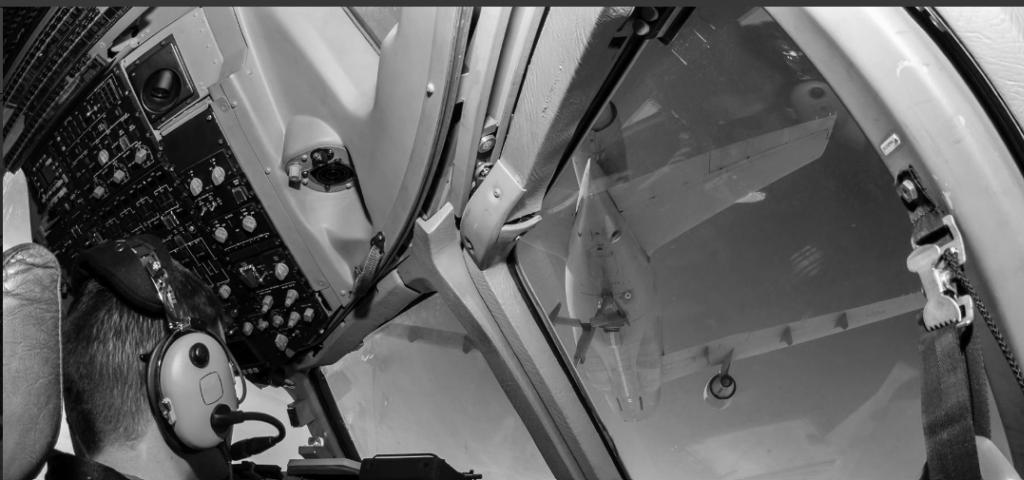
Avionics and the Intelligent Edge
By Christine Stevens
At the 2021 AFCEA Lexington-Concord New Horizons conference, Lauren Knausenberger, USAF CIO, emphasized that USAF’s next generation airborne platforms need to behave with a Tesla-like approach, combining sensing, autonomous operations, and edge cloud: “This is a network at work,” she declared. So how can we in the aerospace and defense industry digitally transform avionics systems so that they too operate like a cloud-native, intelligent edge platform? What would that look like?
Incorporating Advanced Technologies
Avionics systems already face significant challenges in terms of functionality, maintainability, and obsolescence. Future systems will have even more demanding requirements in terms of software-defined architectures, increasingly stringent safety certification requirements, and open standards support (more on this in a moment). Digitally transformed avionics will rely heavily on advanced software for motion planning, trajectory prediction, and predictive analysis integrated with sensor fusion. These systems will analyze massive amounts of data to perform next gen functions. They can develop and deploy systems running applications such as machine learning and analytics. This allows them to make constant improvements as part of a digital feedback loop, which in turn enables endless adaptability. Current methods for assessing software technology readiness level (long known as “TRL” in the defense industry) may need to be redefined in the face of a DevSecOps-compliant, CI/CD world.
A typical avionics suite combines safety-critical VxWorks applications alongside embedded Linux applications and general-purpose operating systems, such as Microsoft Windows, and other third-party and legacy operating systems. Accordingly, avionics at the intelligent edge will need to accommodate mixed-criticality support: Hardware-enforced isolation that allows safe and non-safe applications to run in parallel on separate cores, thereby increasing safety, security, and robustness; and virtualization to support multiple guest operating systems
Bridging Old and New, Cost Effectively
As was also mentioned during the New Horizons conference, as much as we might like to fantasize about futuristic systems, the reality is “we go to war with what we’ve got today.” And it’s not just bridging legacy systems. In total, customers on both the commercial and government sides of our business want to accelerate speed to deployment; reduce total cost of ownership while also reducing risk; migrate to open source; consolidate multiple hardware types; accommodate mixed level criticality; and keeping our certifications for a diverse range of operating environments. The current state of the art is to employ an embedded virtualization platform that acts as an “asset bridge”, enabling the consolidation of legacy applications and previously developed intellectual property on a modern, scalable platform.
Operating at the Speed of Relevance
The 2018 National Defense Strategy issued the mandate to “operate at the speed of relevance,” which, for software developers, often means reducing development time by re-using IP while preparing for the future threat. Standard practice is to employ rapid development environments that are DevSecOps and CI/CD compliant and support “containerization-as-a-service” (CaaS) strategies. For instance, Wind River employs OS-agnostic virtualization and separation technology to ease portability of legacy applications and to support modular architectures. Guest OS support includes VxWorks, Linux, Microsoft® Windows®, and others. Our containerization approach for VxWorks is described here: Containers at the Intelligent Edge, and can be deployed in VxWorks native environment or VxWorks guest OS.
Resilient to Cyber Threats and Harsh Environments
Avionics systems built for the intelligent edge will need to feature advanced virtualization for open, hostile computing environments and robust partitioning that restricts access control and resource allocation to improve the overall integrity of the system. This is especially important when combining real-time, open source and legacy applications. A typical virtualization suite is designed to support an enterprise and is “feature rich”—meaning that the attack surface is increased and performance is reduced. The ideal avionics virtualization platform features fewer lines of code, and therefore, fewer vulnerabilities for an attacker to exploit. It will need to accommodate anti-tamper requirements, as well as separation and isolation, and direct provisioning of hardware for deterministic performance.
Wind River Intelligent Edge Technologies
Wind River has the technological leadership in safety-critical, security, and embedded hypervisor and virtualization solutions required to bring avionics to the intelligent edge--and we continue to accelerate the pace of innovation. Our latest Wind River Studio platform facilitates speed to deployment through single-pane-of-glass operations and is hosted in the users’ own public cloud instance for privacy / security / data ownership. Additionally, Wind River Studio features include:
• DevSecOps: Build any intelligent systems project faster at cloud scale with ML-driven dependency graph analysis to optimize builds
• Security: Secure IP with backup of code and per user secured access, open source license compliance and security vulnerability checking
• Mission-Criticality: Cloud-based development environment for VxWorks and Linux for building mission-critical intelligent systems
• Collaboration: Collaborate across teams in a cloud-based environment with shared projects, container registries, code and artifact repositories
Wind River has a 40-year history of supporting the DOD’s highest priority missions, and we specialize in delivering systems that enable customers to build intelligent AI-enabled edge devices. Developed from the market-leading VxWorks, Wind River’s Helix Virtualization Platform leverages a successful track record of software innovation deployed in over 2 billion devices and more than 90 civilian and military aircraft. NASA has chosen VxWorks to go to Mars on every rover for nearly 25 years—including the latest Perseverance mission. How far can we take you?

